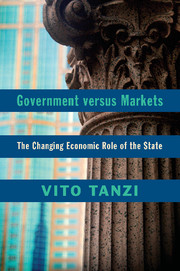Book contents
- Frontmatter
- Contents
- Preface
- PART ONE THE ECONOMIC ROLE OF THE STATE
- PART TWO HISTORICAL REVIEW
- PART THREE THEORETICAL AND ANALYTICAL ISSUES
- PART FOUR THE OUTCOME OF STATE INTERVENTION
- 11 Evaluating the Impact of Public Spending on Socioeconomic Indicators
- 12 Social Protection in the Modern World
- 13 The Role of the State and Economic Performance in the Nordic Countries
- PART FIVE ON THE ECONOMIC ROLE OF THE STATE IN THE FUTURE
- Notes
- Index
- References
11 - Evaluating the Impact of Public Spending on Socioeconomic Indicators
Published online by Cambridge University Press: 07 October 2011
- Frontmatter
- Contents
- Preface
- PART ONE THE ECONOMIC ROLE OF THE STATE
- PART TWO HISTORICAL REVIEW
- PART THREE THEORETICAL AND ANALYTICAL ISSUES
- PART FOUR THE OUTCOME OF STATE INTERVENTION
- 11 Evaluating the Impact of Public Spending on Socioeconomic Indicators
- 12 Social Protection in the Modern World
- 13 The Role of the State and Economic Performance in the Nordic Countries
- PART FIVE ON THE ECONOMIC ROLE OF THE STATE IN THE FUTURE
- Notes
- Index
- References
Summary
The Benefits from Higher Public Spending
Between 1913 and 2000, the share of public spending in gross domestic product for the groups of industrial countries for which data are available rose by about a factor of four. This growth was promoted by the interaction of particular events (wars, Great Depression) with changing views that assumed that government action and more public spending would promote higher social welfare and beneficial structural changes. In much of this period, the strongest pressures on governments were those pushing for higher public spending. They were promoted partly by the growing democratization of countries that had given a vote to a large share of the population.
These pressures for more public spending led to an expansion of the government role in education, with the result that, in many countries, free or at least very cheap schools, at most educational levels, became the norm, and students were required by law to spend increasing numbers of years in school; in health; in the provision of public pensions, reaching eventually a situation where many or most aged individuals (and, increasingly, some not so aged) were receiving, or expected to receive, government-provided pensions; in assistance for the care of the old and the young; in public assistance to the unemployed and the needy in general; in assistance to families with children; in assistance to families unable to find accessible housing; in assistance to loss-making enterprises; and in other less visible programs.
- Type
- Chapter
- Information
- Government versus MarketsThe Changing Economic Role of the State, pp. 229 - 250Publisher: Cambridge University PressPrint publication year: 2011



